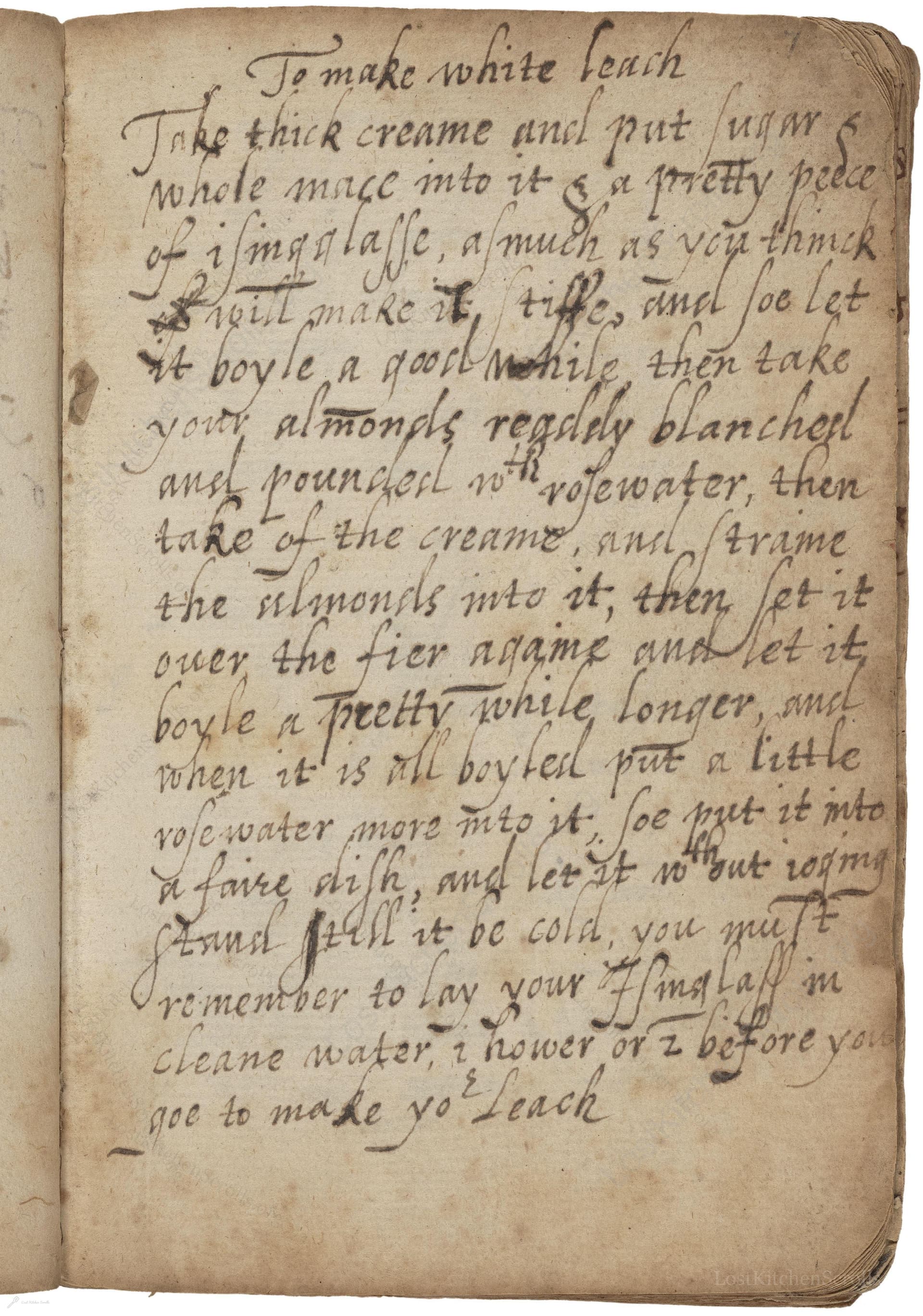To Make White Leach
From the treasured pages of Medicinal and cookery recipes of Mary Baumfylde
Written by Mary Baumfylde

To Make White Leach
"Take thick creame and put sugar & whole mace into it & a pretty peece of ifinglasse, as much as you thinck it will make it, stiff, and soe let it boyle a good while, then take your almonds readely blanched and poundesd with rosewater, then take of the creame, and straine the almonds into it; then let it owen the fier againe and let it boyle a pretty while longer, and when it is all boyled put a little rosewater more into it, soe put it into a faire dish, and let it to but warming and will it be cold, you must remember to lay your Isinglafs in cleane water, an hower or 2 before you goe to make yoâ² leach"
Note on the Original Text
The recipe is written in a conversational, almost shorthand style, reflecting the oral tradition and practical knowledge expected of early modern cooks. Spelling was not standardized ('ifinglasse' for isinglass, 'boyle' for boil, 'blanched' for blanched), and quantities were often imprecise ('a pretty peece'), relying on the cook’s experience. The order prioritizes process over precise measurement, with a focus on sensory cues (thickness, boiling time, scent of rosewater) instead of fixed timings or temperatures. This style assumes familiarity with kitchen work and common ingredient preparations of the time.

Title
Medicinal and cookery recipes of Mary Baumfylde (1626)
You can also click the book image above to peruse the original tome
Writer
Mary Baumfylde
Era
1626
Publisher
Unknown
Background
A sumptuous journey into early 17th-century English cookery, this delightful volume offers a tantalizing glimpse into the recipes, flavors, and culinary secrets that once graced aristocratic tables. Prepare for a taste of history, presented with wit and wisdom!
Kindly made available by
Folger Shakespeare Library
This recipe hails from the early 17th century, recorded by Mary Baumfylde in 1626. White leach was a delicate and fashionable set cream dessert, often flavored with exotic spices like mace and floral waters, epitomizing the luxury and refinement of early modern English banquet tables. Such dishes were commonly served at feasts, banquets, and festive occasions among the elite, where the clarity and purity of a 'white' jelly signaled sophistication and wealth, due especially to the cost of ingredients like almonds, rosewater, and sugar.

In the past, cooks would have used a brass or copper pot over an open hearth for simmering the cream mixture. Almonds would be blanched and pounded in a large mortar and pestle, and straining would be done with a muslin cloth or fine sieve. Moulds or shallow dishes made from pewter, ceramic, or glass would have been used to set the leach. A wooden spoon or paddle for stirring was essential, and the dish would cool in a pantry or cellar rather than a modern refrigerator.
Prep Time
30 mins
Cook Time
15 mins
Servings
6
We've done our best to adapt this historical recipe for modern kitchens, but some details may still need refinement. We warmly welcome feedback from fellow cooks and culinary historians — your insights support the entire community!
Ingredients
- 1 pint (20 fl oz) double cream
- 2.6oz caster sugar
- 1 blade mace (or 0.07oz ground mace)
- 0.35oz leaf gelatine (or powdered gelatine as substitute for isinglass)
- 3.5oz whole almonds
- 0.67 fl oz rosewater (used in two parts)
- Clean cold water (for soaking gelatine)
Instructions
- To make white leach in a modern kitchen, begin by soaking 0.35oz of leaf gelatine (the modern equivalent of isinglass) in clean cold water for 1-2 hours ahead of time.
- In a saucepan, combine 1 pint (20 fl oz) of thick double cream with 2.6oz of caster sugar and 1 blade (or 0.07oz ground) of mace.
- Gently heat the mixture to a simmer.
- Meanwhile, blanch 3.5oz of whole almonds then pound them to a paste with 1 tablespoon (0.5 fl oz) of rosewater.
- Remove the soaked gelatine from the water and add it to the hot cream mixture, stirring until fully dissolved.
- Then strain the pounded almond mixture into the cream using a fine sieve or muslin.
- Return everything to the heat and simmer gently for another 5-8 minutes, stirring.
- Remove from heat and add another teaspoon (0.17 fl oz) of rosewater.
- Pour into a serving dish or mould and allow to cool to room temperature, then refrigerate until fully set—about 2-3 hours.
- Slice and serve chilled.
Estimated Calories
400 per serving
Cooking Estimates
Preparing the ingredients, such as soaking the gelatine and blanching and pounding the almonds, takes about 30 minutes. Cooking the cream mixture and letting the gelatine dissolve takes another 15 minutes. Setting in the fridge takes around 2-3 hours, but you only need to be hands-on for the first 45 minutes or so. Each serving has about 400 calories, and the recipe makes 6 servings.
As noted above, we have made our best effort to translate and adapt this historical recipe for modern kitchens, taking into account ingredients nowadays, cooking techniques, measurements, and so on. However, historical recipes often contain assumptions that require interpretation.
We'd love for anyone to help improve these adaptations. Community contributions are highly welcome. If you have suggestions, corrections, or cooking tips based on your experience with this recipe, please share them below.
Join the Discussion
Rate This Recipe
Dietary Preference
Culinary Technique

Den Bockfisch In Einer Fleisch Suppen Zu Kochen
This recipe hails from a German manuscript cookbook compiled in 1696, a time whe...

Die Grieß Nudlen Zumachen
This recipe comes from a rather mysterious manuscript cookbook, penned anonymous...

Ein Boudain
This recipe comes from an anonymous German-language manuscript cookbook from 169...

Ein Gesaltzen Citroni
This recipe, dating from 1696, comes from an extensive anonymous German cookbook...
Browse our complete collection of time-honored recipes



